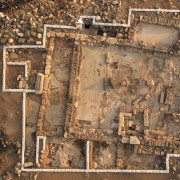Ḥȯrbat Kūr: Climate Research at the Sea of Galilee
Funding of a Palynological Project under the Auspices of the „Kinneret Regional Project“
Jürgen Zangenberg (Leiden)
The unexpected discovery of a cistern, sealed since antiquity and with undisturbed sedimentation, just north of the Byzantine synagogue at Ḥȯrbat Kūr (Galilee), allowed the Kinneret Regional Project to conduct systematic research on the vegetation and microclimate in the vicinity of the related settlement – thanks to the financial support of the DPV. A first limited batch of palynological samples extracted by Frank Neumann (University of Münster) confirmed the high potential of the cistern‘s contents. The initial results have already been published in a preliminary report. The pollen points to an open, grassy semiarid landscape with an apparent scarcity of cultivars and trees in the vicinity of the site and an abundance of herbs. Such an environment was ideal for pasturage; however, olive trees and vines were not identified.
More samples were collected in 2012 in a stratigraphic section through the sediment and are currently under analysis. So far, identified was not only pollen from various regional plants, but also an unusually rich and wellpreserved microzoological assemblage that calls for additional research on the paleoecology of Ḥȯrbat Kūr and the wider surroundings. Apart from the unique paleobotanical and paleozoological material, the cistern also proved a real trove of local pottery from ca. 400 CE. So far, nearly 30 mostly complete jugs and cooking pots were extracted from the fine silt in the cistern, some types of which were so far only known from fragmented vessels.
Further Information
Further projects funded by the Society
Dieser Beitrag ist auch verfügbar in: German







